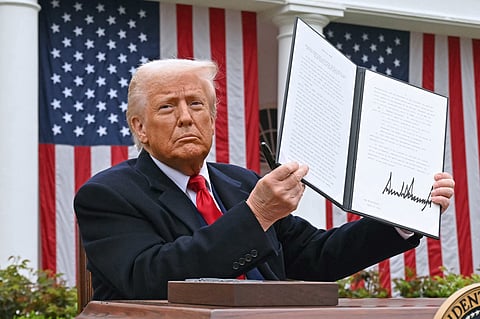
- NEWS
- the EDIT
- COMMENTARY
- BUSINESS
- LIFE
- SHOW
- ACTION
- GLOBAL GOALS
- SNAPS
- DYARYO TIRADA
- MORE

The unloading of bank stocks led to the deluge of red ink in stock markets in the region, as fears intensified of a global recession due to the sweeping tariffs introduced by US President Donald Trump.
Yet, Philippine lenders appear to have escaped the worst impact of Trump’s “Liberation Day” offensive.
Credit watchdog Moody’s Ratings assessed that Philippine banks face the “least damage” from Trump’s tariffs in the Asia-Pacific region.
The fallout was contained mainly due to the Philippines’ lower reciprocal tariff rate of 17 percent, compared to higher levies on other countries, exceeding 50 percent on China, which may limit the economic fallout for domestic banks.
Domestic banks benefit from an economy less directly exposed to US export disruptions than some regional peers like Japan, South Korea or China, which rely heavily on the American markets.
However, local banks are not entirely shielded. The tariffs could dampen global trade, potentially affecting the export-oriented sectors and remittance flows, which are critical to consumer spending and loan repayment capacity.
Analysts have noted that a slowing global economy could lead to tighter financial conditions, margin compression and increased credit risks, challenges that would test banks’ profitability and asset quality.
Despite the pressures, sentiment from local analysts and the peso’s relative strength against the dollar suggest underlying stability.
The Bangko Sentral ng Pilipinas has room to ease monetary policy, with forecasts of a 75-basis-point rate cut in 2025, which could support banks by boosting loan demand and easing borrower stress.
Moreover, the banking sector has historically shown resilience in turbulent times, bolstered by strong capitalization and a focus on domestic retail banking rather than heavy reliance on trade financing.
Sustained global uncertainty could still strain local banks’ performance, making their ability to adapt to a potentially slowing economy a key factor.
The sharp downturn came as investors calculated that an economic slowdown would hit lenders’ asset quality and profitability and curb dealmaking.
The drubbing of bank stocks was particularly severe in Japan, reflecting investors’ receding hopes of rate rises that would have boosted profitability.
The TOPIX banking subindex closed down 10.0 percent, with a 7.8 percent fall in the broader TOPIX index.
Hong Kong-based bank stocks were also hit hard. HSBC Holdings and Standard Chartered led the fall on Monday, declining by 14.8 percent and 16.1 percent, respectively.
Bank of East Asia, a major local lender heavily reliant on mainland Chinese business, dipped 11.2 percent, and Dah Sing Financial Group lost 12.2 percent.
The benchmark Hang Seng Index, in which HSBC has the second-biggest weighting at 8.36 percent, lost 13.2 percent.
The falls of major Chinese state-owned lenders were relatively less severe, between 8 percent and 11 percent, for the big four: the Industrial and Commercial Bank of China, China Construction Bank, Agricultural Bank of China and Bank of China.
DBS Group Holdings fell 9.3 percent in Singapore, while Oversea-Chinese Banking Corp. and United Overseas Bank declined 6.9 percent and 6.3 percent, respectively.
Eunice Tan, a Singapore-based credit analyst at S&P Global Ratings, said slower global growth would hit trade-centric Asia-Pacific.
“There is also a potential for risk-off sentiment to take root, amplifying the economic effects through raising financing costs.”
In South Korea, shares in KB Financial Group declined 7 percent, while Hana Financial Group dropped around 6 percent.
Investors’ appetite for Japanese bank stocks had been rising on the expectation that the Bank of Japan would continue its policy normalization and allow banks to improve their profit margins.
Until last month, MUFG, Japan’s largest bank with substantial exposure in the Philippines, was rewriting its all-time highs daily. MUFG shares have fallen by 26 percent since the end of March.
“Some investors bought bank shares on borrowed money. They are now facing margin calls and may be forced to liquidate the positions,” said Mutsumi Kagawa, senior market analyst at Marine Strategies.
He noted that the worsening business environment could affect bank lending, which has been growing due to vigorous deal-making activities such as mergers and acquisitions and management buyouts.
“Expectations for an additional interest rate increase this year have receded, so have expectations for an improvement in bank earnings,” Hideo Kumano, chief economist at Dai-ichi Life Research Institute, said.
“There are concerns that banks will face rising credit risks,” Kumano said. “At this point, the sell-off is based on expectations of credit losses, but they could become real losses in the future.”
The scaled-back expectations for policy normalization were also reflected in the 10-year Japanese government bonds yield, which dropped to around 1.1 percent on Monday from close to 1.6 percent just 10 days ago.
